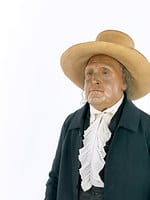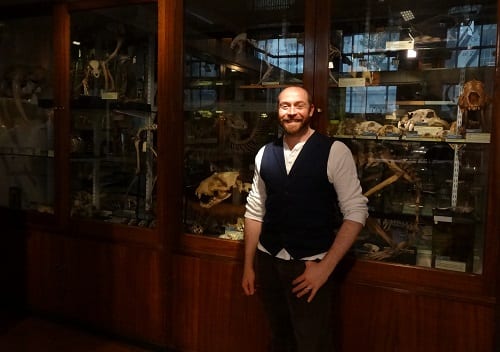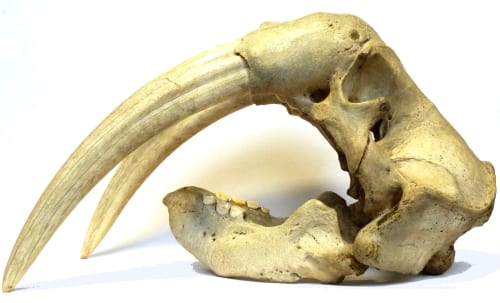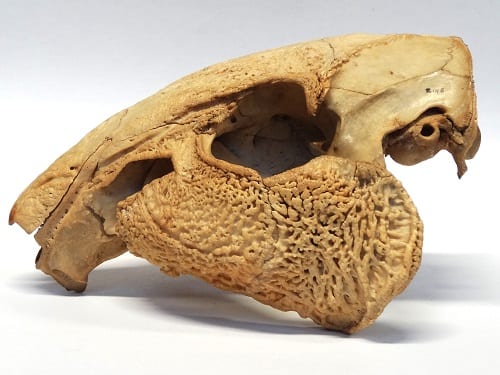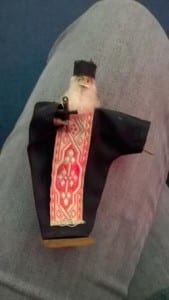Who turned out the lights on Jeremy Bentham?
By Nick J Booth, on 9 November 2015
The auto-icon of Jeremy Bentham is 183 years old and counting. Over this time it has attended parties and UCL council meetings, had its heads (wax and mummified) stolen by students, twice visited Germany and also taken a ride in a red Morris Marina. It’s fair to say that Jeremy Bentham has led an active after life, and UCL Museums are committed to ensuring that it survives for another 183 years and more.
During recent conservation work it has become apparent that although the auto-icon appears safe and secure it is actually subject to a very damaging environmental factor – high light levels (Cue dramatic sounds and possibly someone screaming in the distance).
Ok so actually of all the risks the auto-icon faces this doesn’t sound like a particularly bad one, especially compared to fires, wars, insect infestation and the afore mentioned head thefts (all of these the auto-icon has survived at one point in its life). But high light levels are a huge danger to the auto-icon, and can cause irreparable damage.
Specimen of the Week 213: The Enigmatic Gibbon
By tcrnrh1, on 9 November 2015
Hello Grant Museum blog readers and zoology enthusiasts, it’s Rachel Bray here. You may be wondering who I am, unless you saw a Specimen of the Week blog by me back in May when I temporarily joined the Museum for my MA placement. I am very lucky to be back at the Grant until Christmas to work with the Museum’s wonderful learning and events programme. As part of my return I’m pleased to be getting back into the Specimen of the Week swing of things by researching this week’s candidate which is…
Hello! I’m the new Grant Museum Curator
By ucwepwv, on 6 November 2015
My name is Paolo Viscardi and I’m the new Curator of the Grant Museum of Zoology at UCL.
I have a background in biomechanics and comparative anatomy, with a particular fondness for bones, which I’ve been writing about since July 2009 on my personal blog Zygoma. In my spare time I am Chair of the Natural Sciences Collections Association (NatSCA) and I run the science communication event Science in the Pub (or PubSci for short). My passion for communicating science also keeps me busy giving talks and getting involved in all sorts of events and performances, from immersive theatre to providing a scientist’s response to art. Read the rest of this entry »
The Unbelievable Truth about Sir Francis Galton
By Subhadra Das, on 5 November 2015
I have a motto: If at a loss, take inspiration from a tried and tested Radio 4 format.
This week it’s The Unbelievable Truth, the panel show built on truth and lies. Each panellist presents a short lecture on a chosen subject and scores points for how many truths they can smuggle past the other players. Panellists win points for spotting truths, and lose points if they mistake a lie for a truth. Seeing as I’m the only one presenting, the lecture is longer than normal and contains 15 truths rather than the usual 5. In the interest of investing in a civilised society, I will be trusting you to keep your own score.
This week, my subject is Sir Francis Galton, the Victorian scientist and statistician who propounded the term eugenics.
Glass delusions from the ancient Egyptian world
By Alice Stevenson, on 4 November 2015
This post is part of a series exploring the exhibition Glass Delusions at the Grant Museum of Zoology.
We often visualize ancient Egypt in sandy hues against the backdrop of a clear blue sky, or the watery Nile framed by green vegetation. Yet there was a much wider palette of colours used in the adornment of palaces, temples and decorative objects. The Egypt world was brightly, sometime garishly, vibrant with colour. Glass was one of the luxury materials that came to be used for decoration during the period Egyptologists call the New Kingdom, around 1500 BC.
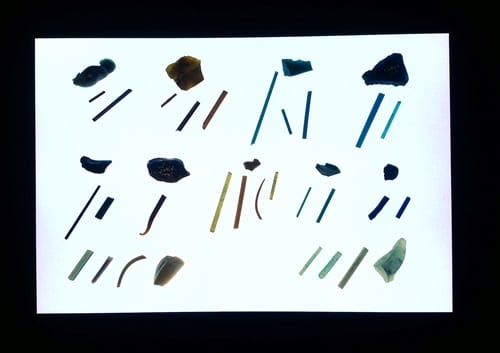
Armana glass rods on display in Glass Delusions at the Grant Museum of Zoology.
18th Dynasty, Amarna, From the Petrie Museum collection (UC22911 – UC22920)
Specimen of the Week 212: I am the Walrus
By ucwepwv, on 2 November 2015
After spending my Halloween weekend dressed as a vampire, I’ve been thinking a lot about animals with big fangs that feed by suction.
That’s right, my Specimen of the Week is…
Underwhelming Fossil Fish of the Month: October 2015
By Mark Carnall, on 30 October 2015
It’s that time of year, the leaves are turning brown, Christmas advent calendars are on the shelves, British people are struggling with the decision to complain about it being too hot or too cold for the time of year because its possibly both but not as clear cut as say summer or winter. But none of that matters to a fossil fish. Even if they were able to blink in life, which most couldn’t, the unblinkable, unblinking eyes of fossil fish care not for such trivial concerns as the changing of seasons. Partly because they’ve been turned to stone. Well, completely because they’ve turned to stone.
Welcome to October’s underwhelming fossil fish of the month, our monthly foray into the world of underwhelming fossil fish from the drawers and stores of the Grant Museum of Zoology. The unloved, the untreasured, the uncelebratable fossil fish. And so they should be. They’re not very interesting at the best of times. In fact, I wouldn’t carry on reading this, you’ll only be disappointed in 5, 4, 3, 2… Read the rest of this entry »
How to make a diamond
By Jack Ashby, on 28 October 2015
This is a guest post from our artist in residence Eleanor Morgan. It is part of a series exploring the exhibition Glass Delusions at the Grant Museum of Zoology.
This year, on Thursday the 30th of July, I made a diamond. Only a few weeks before, this diamond had been floating around the River Thames in the form of dead plants and animals. It had taken a few hours, high pressure and temperature and most importantly a lot of help from UCL chemists and geologists to transform the dead creatures of the River Thames into tiny diamonds. These can now be seen at the Grant Museum as part of my exhibition Glass Delusions, along with a booklet ‘How to make a diamond’ which describes the process. Read the rest of this entry »
Specimen of the Week 211: A Cheeky Chappie – The Lowland Paca
By ucwepwv, on 26 October 2015
Hi, I’m Paolo and this is my first blog post as Curator of the Grant Museum of Zoology, picking up the reins from Mark Carnall. I’ve chosen this specimen of the week based simply on the fact that it has very interesting cheeks – or ‘zygomatic plates’ if you speak zoologese.
This gnarly-cheeked Specimen of the Week is…
Read the rest of this entry »
Introducing Museums and Wellbeing
By Maria Patsou, on 22 October 2015
Hallo! My name is Maria and I am the research assistant for the National Alliance of Museums, Health and Wellbeing based at UCL PACE. Funded by Arts Council England, we’ve launched the Alliance so that information about museums and health can be shared and to provide support for those individuals and organisations working in this area of activity. My main role is to map existing practice, literature, reports and evaluation on health & wellbeing activities in the museum sector in the UK. I also carry out research into health and social care structures and identify key contacts for museum people. I am having an amazing time in this role as I get to work on the wider categories of arts, culture and health, which I have been specialising on for the past few years, through clinical and academic work.
Late September was very exciting for museums and wellbeing. I participated in a Horniman Museum training on the use of museum objects for creativity and learning. While going through the Hands-on Base gallery, I accidentally bumped into a Greek Orthodox priest miniature (Picture 1).
 Close
Close


